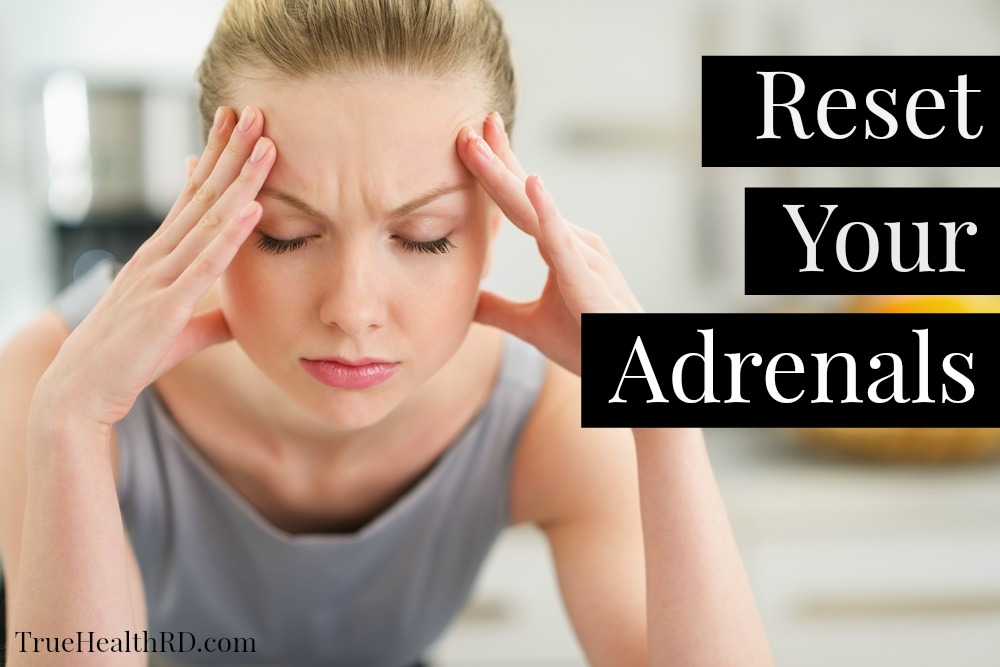If you find yourself over-caffeinated and still tired, feeling zapped or stressed, or the scale just won’t budge…your adrenals may be the cause.
What are the adrenal glands?
The adrenal glands are a couple of little lumps of tissue that sit on top of your kidneys. They are orange, spongy, and shaped like tiny pyramids – each of them about the size of a sugar cube and weighs about as much as 1/2 a stick of gum.
Along with the pineal gland, thyroid, ovaries, testicles & pancreas, the adrenal glands are part of the endocrine system, which produces the body’s hormones.
The adrenals partake in a laundry list of functions:
- Regulation of other hormones – other glands release hormones and it’s up to the adrenal glands to release cortisol to allow the hormones to enter the cell to do their job. It’s like cortisol holds the key to give hormones access, in our out, of the cell.
+ - Balance of electrolytes – It’s a balancing act with sodium, magnesium, calcium & phosphorus.
+ - In charge of the turning off the inflammatory response – If you bump & cut your elbow, the acute inflammatory response comes the rescue to help heal the injury. When the adrenal glands are in good shape they shut off the inflammation once all that has been repaired or removed is completed.
+
- Sleep & waking cycles – the adrenal glands control the circadian rhythms along with the pineal gland. The pineal gland controls melatonin, the sleeping hormone, and the adrenals control the cortisol which helps you wake up in the morning. Most people who have adrenal dysfunction have improper balance of cortisol fluctuations. A proper cortisol cycle is having higher cortisol in the morning & lower to almost no cortisol in the evening.
+
- Fight-or-flight response – The adrenal glands are mainly known for controlling the body’s fight or flight response – in other words, getting the body in and out of survival mode. Decades ago the main stressors people faced were famine or fear or threat. Now we have more stressors in our lives which puts us in “survival mode” Once in this survival state the body no longer sends energy to the muscles but to our fat cells for a later use.
+
- Blood glucose levels – when you skip a meal your adrenal glands release cortisol, which helps release carbohydrates from the muscles and liver to use for energy. When the adrenal glands are in good shape, most of the pancreas does this and the adrenals play only a small part.
As we all know – what happens when we try to take on more than we can chew? Multi-tasking only results in a lot of half-way-done tasks and not one done well. People aren’t good multi-taskers and neither are the adrenal glands. When overloaded and in a constant low-level of survival-mode none of the adrenal gland’s tasks are done top notch.
Watch where I teach more in the live presentation below…
The Fat Switch & the Fuel Switch
Dr. Alan Christiansen best described the adrenals as having a fat switch and a fuel switch. When we have low stress, low inflammation & our adrenals are thriving the fuel switch is turned to on. When we are stressed, burned out, not getting good sleep & are highly caffeinated the fuel switch turns off and the fat switch turns on.
How Adrenal Imbalances Occur
- Processed foods – processed foods have been shown to increase inflammation & disrupt blood glucose (BG) levels. This inflammation can cause the body to make more cortisol to reduce that inflammation and reduce BG, the same way it does when the body senses fright.
- Fructose – Fructose in particular is high in processed foods. Fructose is the sweetest of all the sugars which is one of the reasons why it’s used to sweeten processed foods. It’s the main sugar in fruit, but note (!), it’s nearly impossible to consume too much fructose by simply eating fruit.
- Toxic proteins – Numerous studies have found that proteins that undergo much processing are linked to chronic inflammation. These proteins include casein, found in dairy; gluten, found in wheat, barley & rye; and albumin, found in eggs. Also, foods today contain higher amounts of these which can trigger survival mode. Toxic proteins are the believed to be the reason behind why allergies such as peanut and shellfish have more than doubled during the last few decades. Plus intolerances that are more subtle markers such as pain or bloating are signs that there’s inflammation taking place. When this takes place the body senses a threat (the proteins) and instead stores the energy because it’s under “attack” and instead shifts it energy and focus on removing the toxins.
- Intestinal flora – Protein changes due to processing, environmental toxins and chemicals (such as BPA & antibiotics) also alter the flora of the gut. When bacteria is imbalanced (dysbiosis), it can alter digestion, improperly breaking down bacteria which makes your body more apt to trigger the immune response.
- Environmental Pollutants – since 1900, over 3 million synthetic chemicals have been released into the world.
- BPA – Bisphenol A – BPA is a by-product of packaging and a contaminant from ground water. BPA gets stored in the fat cells and causes aggressive fat call growth. In 2012 a study out of the United Kingdom, researchers took fat samples from 17 people who had abdominal surgeries & found BPA in every single person studied. The more BPA present the more the participant’s fat cells showed signs of fast growth. Even those with the lowest amount of BPA present showed signs of unusual fat-cell growth.
- Light pollution – Light pollution, the combination of artificial light and lack of natural light damages cortisol cycles, which leads to fat deposition plus disrupts sleep patterns. Studies have found that the adrenal glands actually perform better when light comes from above the eyes. But when the light is from below (like with cellphones, tablets or laptops), this light alters their performance and can affect sleep cycles.
- Pressures of Modern Life – Even though our lives are rarely in danger they are filled with constant low-level stressors such as texts, emails, deadlines, to-do lists and distractions.
- Some estimates state that the pressures of modern life have increased as much as 30% just since the 1980s!
- A study of 54,000 women was tracked over 15 years. At several points during the study, the researchers measured the participants’ body weight and used questionnaires to determine their total stress load. The collected data consistently showed that those who gained the most weight also had the highest stress load.
How to Reset & Rebalance
If inflammation is present, eliminating the following should be the 1st step. The proteins in these foods are tough to digest and are the leading causes of inflammation in the diet.
- Wheat – Gluten is found in wheat, barley & rye and some varieties of oats even though oats are a naturally gluten free food. Gluten is found in bread, pasta, crackers, cereal, baked goods, etc.
- Dairy – Casein is found in all dairy products: milk, yogurt, cheese, sour cream, ice cream, etc.
- Eggs – Albumin is found in both the white and the yolk of eggs.
- Soy – Soy is not recommended as studies have shown soy to disrupt thyroid function and hormonal functions. With soy it’s not a protein problem it’s a hormonal problem as soy is high in estrogen.
- Sugar – found in nearly all processed foods because of it’s addictive nature. Sugar feeds inflammation and taxes the adrenal glands. Stick with only whole fruits.

Correct Adrenal Rhythms with Carb Cycling
Most people who have adrenal troubles have abnormal cortisol levels. Since cortisol levels are affected by carbohydrates, studies have shown carbohydrate cycling can help normalize adrenal rhythms and cortisol cycles. No calorie counting; however, keep portion sizes in mind!
Breakfast – higher in protein and 1 serving of high fiber carb. Think shakes with lots of greens, 1/4 cup of black beans and a good quality protein powder. Or eat foods you don’t normally have at breakfast time such a grilled chicken and broccoli. The best carbs to eat are the ones that digest the slowest such as beans, quinoa and brown rice, and berries. It may sound odd at first to not have a carb-heavy breakfast & eggs but it’s actually more liberating because there’s so many other foods to choose from than the standard breakfast staples.
Lunch – Palm size serving of starch, lean protein and minimal fat, like the size of your thumb. The easiest way to prep for lunch is to get it ready the night before. After dinner when all the food is still out, throw leftovers in a lunch box or assemble a salad your favorite clean dressing.
Snacks – If making it to dinner without something to hold you over isn’t possible, take that opportunity to get more veggies in.
Dinner – Dinnertime is where you’ll have the most carbohydrates; however, be mindful that it doesn’t take much at all! No more than 1 cup or 3 golf ball sized portions of carbs.
1-Day Sample Meal Plan
- Breakfast – protein, little fat & little carb! Low carb muesli, green protein shake, 2 pc nitrite free turkey bacon, 1 small pear.
- Lunch – veggies, protein, minimal fat – think salad & a broth based soup, a “sandwich” on a lettuce wrap or stir-fry with no sugar added garlic sauce.
- Snack – Baby carrots & hummus, celery soaked in lemon juice or plain celery & almond butter, raw okra (trust me, it’s good!) 🙂
- Dinner – Grilled chicken breast with sautéed veggies, steamed broccoli, 1/2 c brown rice & 1/2 fresh pear.
Live It!
Take one thing and start from there. If you’re already gluten-free, start reducing and eliminating anther inflammatory food such as dairy, soy or sugar. Then add another to eliminate once you’ve gotten that one down.If you’re not sleeping well, disconnect at least 30 minutes before bed. Any step in the right direction will get you there.
References:
Wang J, Sun B, Hou M, Pan X, and Li X. 2013. “The environmental obesogen bisphenol A promotes adipogenesis by increasing the amount of 11 beta-hydroxysteroid dehydrogenase type 1 in the adipose tissue of children.” International Journal of Obesity (Lond) 37(7):999-1005. Doi: 10.1038/ijo.2012.173
Jayson, S. 2012. “Stress levels increased since 1983, new analysis shows. “ USA Today, June 13. http://usatoday30.usatoday.com/news/health/story/2012-06-13/stress-increase-over-time/55587296/1
Christianson, Alan. The Adrenal Reset Diet: Strategically Cycle Carbs and Proteins to Lose Weight, Balance Hormones, and Move from Stressed to Thriving. N.p.: n.p., n.d. Print.
Yau YH, and Potenza MN. 2013. “Stress and eating behaviors.” Minerva Endocrineologica 38(3):255-67



